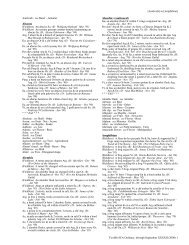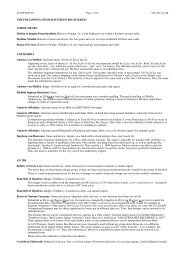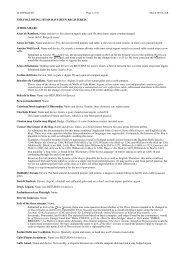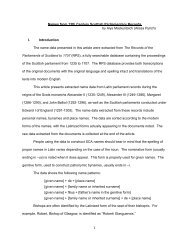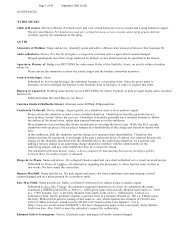Create successful ePaper yourself
Turn your PDF publications into a flip-book with our unique Google optimized e-Paper software.
ACCEPTANCES Page 7 of 20 February 2010 LoAR<br />
On p. 150 s.n. Draycott Moor, he dates the forms Draicote and Dregcota to the Domesday Book. Based on this <strong>in</strong>formation,<br />
and other <strong>in</strong>formation provided <strong>in</strong> the submission and found by the commenters, Ealdercote is a plausible place name <strong>in</strong> Old<br />
English.<br />
In the past, we have allowed designators to be a theme with<strong>in</strong> a name element if (1) the entire construction is appropriate for<br />
the language, and (2) the element act<strong>in</strong>g as a designator is appropriate to the type of item be<strong>in</strong>g registered. In these cases, the<br />
designator is ignored when conflict check<strong>in</strong>g the name. A few examples of this type of registration <strong>in</strong>clude:<br />
Grimwithshire (05/2005 via An Tir)<br />
Bentonshire (04/2003 via Trimaris)<br />
Mædscir (05/2000 via the Outlands)<br />
Wastekeepshire (11/1980 via the West)<br />
Ladyhall (registered to Starhelm Warlock, 01/1973 via the West)<br />
The mean<strong>in</strong>g of ’cottage’ seems to be an appropriate mean<strong>in</strong>g for a household name registered to an <strong>in</strong>dividual; a person could<br />
certa<strong>in</strong>ly have a piece of land with a cottage on it. As this name is documented for a time when a ’cottage’ name would have<br />
been literal (the name of someone’s cottage or farmstead), it is reasonable to allow -cote to act as the designator <strong>in</strong> this name as<br />
it complies with RfS III.2.b.iv Household Names which requires that "Household names must follow the patterns of period<br />
names of organized groups of people."<br />
Therefore, as Ealder is clear of conflict, we may register Ealdercote as a household name.<br />
Elizabeth Tender Herte. Name and device. Per fess vert and azure, three hearts Or and a hand fesswise reversed <strong>in</strong>verted argent.<br />
Submitted as Elizabeth Goudhart alias Tender-Hearted, the submitter allowed all changes and specified that if the name must<br />
be changed, she cared most about both mean<strong>in</strong>g and sound and specified "Tender-Hearted" as the mean<strong>in</strong>g/sound desired.<br />
Tender-Hearted was submitted as a descriptive nickname. We have long decl<strong>in</strong>ed to register English bynames formed from<br />
adjectival past participles, barr<strong>in</strong>g evidence for their usage:<br />
While the LoI documented the word "distract" to very late period, no evidence was presented, nor could any of the<br />
commenters f<strong>in</strong>d any, to demonstrate that epithetical nicknames were constructed <strong>in</strong> this way from a fairly abstract<br />
past participle. Without such evidence, we are unable to register this. [Deirdre the Distracted, LoAR 04/1994,<br />
Ansteorra-R]<br />
Submitted as Elisabeth the Brown-Eyed, English bynames were not formed from adjectival past participles.<br />
[Elisabeth Browneye, LoAR 09/1994, East-A]<br />
No new evidence was provided for the use of abstract adjectival past participle bynames <strong>in</strong> English, so they cont<strong>in</strong>ue to be<br />
unregisterable.<br />
However, Magnus von Lübeck found a number of citations support<strong>in</strong>g a description mean<strong>in</strong>g ’tender heart’ <strong>in</strong> the Middle<br />
English Dictionary (s.n. tender) dat<strong>in</strong>g as early as a1325. A few of these examples are:<br />
a1325(c1280) SLeg.Pass.(Pep 2344) 1442: Gret deol made þat symple ffolk.. Wymmen of tendre heorte loude wope.<br />
a1400(a1325) Cursor (Vsp A.3) 24245: Mi suet moder, tender of hert, Nu comforth þe.<br />
c1425(a1420) Lydg. TB (Aug A.4) 1.2956: Wommen ben of so tender hert Þat þei wil gladly of rou3te and<br />
pite..Sauen his life.<br />
c1450(c1370) Chaucer ABC (Benson-Rob<strong>in</strong>son) 180: Nere thi tender herte, we were spilt.<br />
Based on these examples, Tender Herte is a plausible descriptive byname.<br />
However, no evidence was provided, and none could be found by the College, for the use of X alias Y constructions where X<br />
and Y are anyth<strong>in</strong>g other than <strong>in</strong>herited surnames. S<strong>in</strong>ce no support was provided for Tender-Hearted or Tender Herte as an<br />
<strong>in</strong>herited surname, the construction Goudhart alias Tender-Hearted does not follow period examples of X alias Y.<br />
As the submitter allows all changes and we must drop one of the bynames <strong>in</strong> order to register this name, we have reta<strong>in</strong>ed the<br />
element closest to the mean<strong>in</strong>g and sound she specified that she desired.<br />
Guilhelmes de L<strong>in</strong>ivilla. Name and device. Erm<strong>in</strong>e chaussé gules, a wyvern erect contourny azure.<br />
Imran Yosuf le Scorpioun. Redesignation of device as badge. Azure, a scorpion tergiant erect with<strong>in</strong> a bordure argent.<br />
Dur<strong>in</strong>g LoAR process<strong>in</strong>g, it was noted that Imran had two pieces of armory designated as his device. This was his <strong>in</strong>itial<br />
device, which should have been either released or redesignated <strong>in</strong> 1987 when he changed his device. We are, therefore,<br />
redesignat<strong>in</strong>g this armory as a badge. The 1987 device Quarterly gules and sable, a swan rousant, w<strong>in</strong>gs displayed, argent,<br />
beaked and membered, with<strong>in</strong> a bordure Or, rema<strong>in</strong>s his device.<br />
Kateryne Ferneley. Device. Per chevron wavy vert and argent, two domestic cats sejant guardant contourny and a fern frond<br />
counterchanged.<br />
Tómas Tryggvason. Name.<br />
William Sexton. Device. Argent, on a flame gules a castle argent, a chief doubly enarched azure.<br />
This is clear of the device of Arthur of the Serpent<strong>in</strong>e Trail, Argent, on flames of fire gules a tower argent, a chief enarched<br />
sable. There is a CD for the change of t<strong>in</strong>cture of the chief and a CD for the change from a chief enarched to a chief doubly<br />
enarched. Precedent says:<br />
[A chief Or vs. On a chief double enarched Or, three mullets] There is clearly a CD for the addition of the mullets,<br />
but is the double arch<strong>in</strong>g of the chief worth a second CD? It has been previously ruled that there is not a CD between<br />
a chief s<strong>in</strong>gly arched and a pla<strong>in</strong> chief: "the arch<strong>in</strong>g here is virtually identical to that shown on period renditions of a<br />
pla<strong>in</strong> chief and adds almost no visual difference" (AMoE, LoAR 19 March 1988, p. 12)<br />
Chiefs double arched have been acceptable <strong>in</strong> the S.C.A. for over twelve years. Accord<strong>in</strong>g to J.P. Brooke- Little, the<br />
first use of this l<strong>in</strong>e of partition seems to have been <strong>in</strong> 1806 <strong>in</strong> a grant to William Proctor Smith: Gules, on a chief<br />
double arched Or, three trefoils proper. (Fox-Davies, A Complete Guide to <strong>Heraldry</strong>, 1969 revision, footnote, p. 75)<br />
Therefore, there is no period evidence upon which to base a decision. However, from this example, we can <strong>in</strong>fer that<br />
n<strong>in</strong>eteenth century heralds viewed double arch<strong>in</strong>g to be different from a straight l<strong>in</strong>e of partition; at least a<br />
blazonable difference.<br />
From a visual perspective, s<strong>in</strong>gle arch<strong>in</strong>g has been used to give representation to the curvature of a shield, especially<br />
with bends. Double arch<strong>in</strong>g does not appear to be an artistic method of denot<strong>in</strong>g curvature. It <strong>in</strong>volves a dist<strong>in</strong>ct<br />
action <strong>in</strong> the draw<strong>in</strong>g of the l<strong>in</strong>e of partition <strong>in</strong> the same way as bevill<strong>in</strong>g. This makes it one step removed from a



